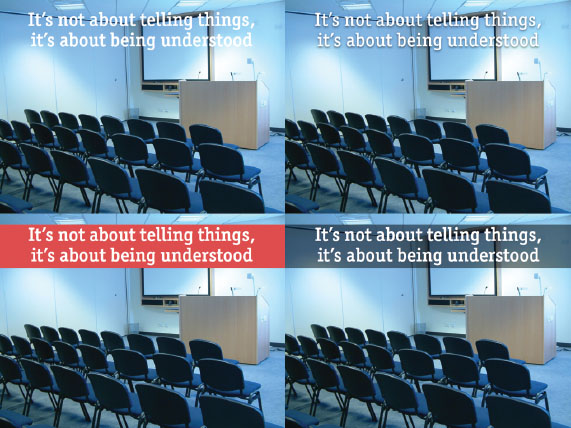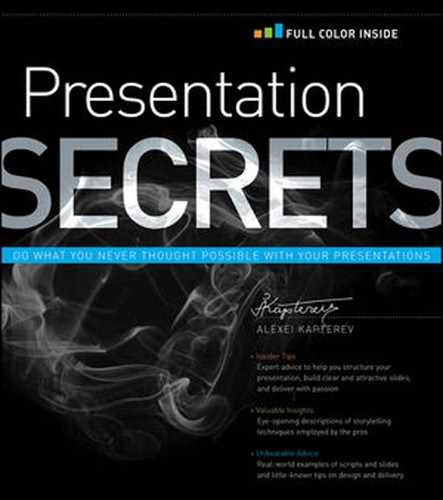UNITED WORLD IN A SLIDE DECK
Your slides are a separate reality. It's a different world with its own laws. You are the master of this world, its creator, and you are responsible for setting up those laws. What colors exist in this universe? Is it 3D or 2D? Is it hand-made or computer-generated? It is new or old? Is it classy or informal? One of the tests for truth, for believing in something, is consistency and coherence. Do the elements match one another or do they conflict? When you're adding a shadow to a text box, ask yourself if you have shadows in this world. If one box has a shadow, everything else must have a shadow, too. There are many questions to answer, and it will be actually easier for you to borrow most of the laws from the reality you see around yourself every day. We don't see many text boxes around us, do we? However, we see a lot of signs with frames. It could be a road sign made of tin or just a piece of paper affixed to a wall. What physical object does your text box represent? Is it paper? Is it glass? Is it stone? Is it metal?

FIGURE 7-26: Combining pictures and text.
What about letters? In our reality letters could be printed, written, or drawn. If they are big enough they can also be physical and have depth, drop shadow, create a reflection. This could work just for a few letters, not for a large block of text. What about lines? A line could be drawn with a marker or with a pen. Can it possibly have shadow? No way. An arrow can exist as a drawing, in print, or as an object. Again, an object can have a realistic shadow, but the drawing can't. Here's an object that can never exist in reality: handwriting with a shadow or with a 3D effect applied. It's impossible and, therefore, unbelievable. In other words, whatever you do, try not to do it unless you really mean it.
NOTE One thing that I really like about the Mac OS X interface is that I am always pretty sure where I am. I am in the world of metal and glass. The window border is metallic grey (probably aluminum alloy?), and the buttons are clearly glass. Now if I look at Windows 7 interface I don't know what I see. Aero? Yes, but what exactly is “Aero”?
Figure 7-27 shows a couple of examples of things that do and don't work. The first slide has a stylish 19th century border; you cannot use a modernist Futura font here. You also cannot use old-fashioned scrapbook-style picture frames with color photos. This background demands a formal font, sepia pictures, and frames that resemble actual old photographs. The next slide's background looks very industrial and modern. You can't really print on this surface so you have to pretend that your letters are physical, so give them a shadow. Also, if you give your picture some depth, make it 3D, it will work better. And, of course, you cannot have any handwriting here.

FIGURE 7-27: Consistency and inconsistency in your slides.
These two examples have one thing in common; they have very strong backgrounds that define most of the laws. What if your background is white? Then you have more freedom, which isn't necessarily good. You have fewer rules and have to make intelligent choices every time. So you have to make the white background stronger. A white background usually invokes a paper-like metaphor. Now you have to fully capitulate to the fact that your background is paper. This is a paper reality. You now cannot have text with shadows anymore because your letters are printed. Your boxes and arrows now should also be printed, hand-drawn, or made of something physical—plastic, glass, or metal. Make your next decision and then follow it. Remember that simple laws often produce very complex and interesting behavior, whereas complicated laws produce stupid behavior.
NOTE Of course, laws are made to be broken. Sometimes you can create an interesting juxtaposition by adding a 3D object to an antique background, but then this becomes a law. This is what your new world is now about. You have to keep adding 3D objects.
Over the past couple of years, gradients become very popular. I now see people using gradients in every other presentation. However, it almost never occurs to them that gradients are not decoration. They have a purpose, which is to give an object depth. Gradients are how people see light bouncing from different surfaces under different angles. When you are adding gradients to your text box, you are creating a 3D object and now you have a 3D universe. You have to make sure that everything conforms to that rule.
Figure 7-28 shows a couple of gradient examples. The topmost example doesn't work. Unless this is a legend for heat map, it is absolutely impossible. How can you make red become blue and, more importantly, why would you want to? The middle one isn't good either. Supposedly, the light is so bright that the blue almost disappears. Why don't you just make something about that light? It makes your text fade. Gradients like this might work for arrows but this is the only exception I can come up with. The last example is better. The contrast is subtler, the text is visible, and it starts to resemble how things actually look in real life. (Go back to look at one of President Obama's slides in Chapters 5 or 6. See how gradient is applied there.)

One final thing. Don't try to make it look perfect. As Frank Roche (whom I already quoted elsewhere in this book) said once, “Leaving some raw edges in communication makes it real.”
This is true; real things aren't perfect. There's a whole Japanese concept of aesthetics called Wabi-sabi, which is described “beauty of things that are imperfect, impermanent, and incomplete.” We all understand that your slides were made by a person and not by a precision slide-making robot. It's the same thing as with handwriting. It is attractive because it is human. No two handwritten letters are the same because it's just impossible to make them the same, so we don't even expect them to be the same. If they are sufficiently alike, we trust the handwriting to be authentic. It isn't about being exceptionally strict with any of the rules; it is about keeping the tone of your communication consistent. And this is what the next chapter is mostly about.
